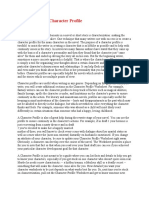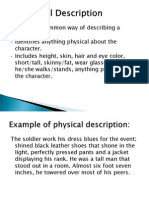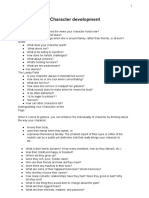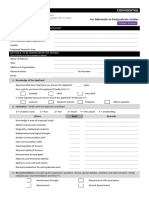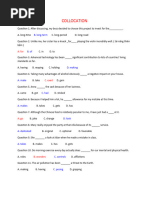Assist: How To Approach A Character Sketch
Assist: How To Approach A Character Sketch
Uploaded by
RAJIVCopyright:
Available Formats
Assist: How To Approach A Character Sketch
Assist: How To Approach A Character Sketch
Uploaded by
RAJIVOriginal Description:
Original Title
Copyright
Available Formats
Share this document
Did you find this document useful?
Is this content inappropriate?
Copyright:
Available Formats
Assist: How To Approach A Character Sketch
Assist: How To Approach A Character Sketch
Uploaded by
RAJIVCopyright:
Available Formats
Hello everybody
Welcome to an examination oriented session of English
My name is rajiv Niroula
And today we gonna learn character sketching from Heritage of words.
This video is formulated to assist you in learning. Therefore, it is better to
watch the video with a pen and paper.
Before that, A question---Have you watched my previous video?
If not, then do watch.
Also try to watch my next video . It is already prepared. Please have a look
.
A character sketch is a quick rendering of a character.
In composition, a character sketch is a brief description in story and play of
a particular person or type of person.
In order to write a character sketch, you must ask yourself questions about
your character.
In writing one, you go into the character's manner, distinct characteristics,
nature, and the way that person behaves him or herself.
A character sketch can also be satiric,
How to Approach a Character Sketch
If analyzing a character, you can focus upon, how the person changes, his
or her attitude toward others, and role in the story. You can list the person's
likes and dislikes and how you feel about the character.
Who is your character physically?
Physical characteristics are the first things we notice when we meet
someone. Therefore, this is a good starting point when writing a character
sketch. Is your character a woman or a man? Is he or she tall or short? Is
your character bald? How old is your character? Does he or she have a
disability?
the physical details of the main characters are representations of their
internal state. Without a vivid description of this character's physicality, a
critical dimension of the plot would be lost and the central conflict would be
nonexistent. Answering questions about your character's physicality is the
first step in creating a fully realized character.
What is your character doing?
This is the next question to ask because it brings into account other
aspects of story writing such as setting and time. The answer to this
question will also affect other aspects of your sketch, such as what your
character is tiring or how he or she is feeling. Is your character walking
down the street? Is he or she sitting in a park? Is your character working on
a boat? Asking what your character is doing will not only help you
understand your character, but also his or her relationship to the setting in
your story.
What is your character feeling?
This is probably one of the more complex questions you can ask about
your character. Is your character angry? Is he or she happy, sad, tired, or
depressed? Does your character love something or someone? Asking
questions about your character's emotional life might evolve into the
production of a character history. While this may be tempting, you have to
focus on what your subject is feeling within the context of the story you are
writing. Although the answers to these questions are important, they are
rarely explicitly stated in the story.
Implicitly showing how your character is feeling by his or her interactions
with other characters or the setting is infinitely more interesting to read than
explicitly stating whether your character is happy, sad, elated, joyful, or
miserable.
Well this is the end of our meeting.
I hope, you enjoyed the session.
Thanks a lot for your persistence.
Follow the format.
You can also follow me in my instagram accouct at r-a-j-e-e-v-n-i-r-o-
u-l-a
Till next video , bidding you bye
For further detail, Contact Alternate education Foundation. What it is
for? Well you can see it as nepal’s number one entrance preparation
centre for CMAT, KUUMAT and GMAT. You can also see its location
as it lies opposite to BICC Building at baneswor.
See you again . Bye Bye.
You might also like
- Buidling A Character - Uta Hagen 9 Questions Details100% (9)Buidling A Character - Uta Hagen 9 Questions Details4 pages
- Character Development Questions & Free Printable WorksheetsNo ratings yetCharacter Development Questions & Free Printable Worksheets27 pages
- The Craft of Character: How to Create Deep and Engaging Characters Your Audience Will Never ForgetFrom EverandThe Craft of Character: How to Create Deep and Engaging Characters Your Audience Will Never Forget5/5 (1)
- 150+ Character Questions - Ultimate Character QuestionnaireNo ratings yet150+ Character Questions - Ultimate Character Questionnaire16 pages
- 9: A Journey Through Anglo-American Literature Module 181% (178)9: A Journey Through Anglo-American Literature Module 1145 pages
- Namaste You Are Welcome To Approaching A Character Sketch SessionNo ratings yetNamaste You Are Welcome To Approaching A Character Sketch Session14 pages
- 6 Necessary Parts To A Character Sketch: DescriptionNo ratings yet6 Necessary Parts To A Character Sketch: Description3 pages
- Character Journaling: Developing Stronger Characters From the Inside OutFrom EverandCharacter Journaling: Developing Stronger Characters From the Inside OutNo ratings yet
- Character Development: How To Write Strong Characters in YournovelNo ratings yetCharacter Development: How To Write Strong Characters in Yournovel16 pages
- Character Development: From Fundamentals To Flesh & Bone100% (3)Character Development: From Fundamentals To Flesh & Bone20 pages
- 123 Character Development Questions: A Systematic Way to Develop Phenomenal Fictional Characters.From Everand123 Character Development Questions: A Systematic Way to Develop Phenomenal Fictional Characters.5/5 (1)
- Acting as a Way of Life: A Handbook on How to Act - for Beginners as Well as for ProfessionalsFrom EverandActing as a Way of Life: A Handbook on How to Act - for Beginners as Well as for ProfessionalsNo ratings yet
- Fat Man Little Boy Movie Discussion QuestionsNo ratings yetFat Man Little Boy Movie Discussion Questions10 pages
- Weird Writing Prompts: Random Questions to Supercharge Your STory: Own Your Unique WordsFrom EverandWeird Writing Prompts: Random Questions to Supercharge Your STory: Own Your Unique WordsNo ratings yet
- 100 Character Development Questions To Inspire Deeper Arcs - NNNo ratings yet100 Character Development Questions To Inspire Deeper Arcs - NN13 pages
- All About Character Flaws: Making Your Characters Miserable & Rewarding Your Readers Forever!From EverandAll About Character Flaws: Making Your Characters Miserable & Rewarding Your Readers Forever!No ratings yet
- Read The Following Text and Answer Do The Activities That FollowNo ratings yetRead The Following Text and Answer Do The Activities That Follow4 pages
- The Tell-Tell Heart: Presented by Rajiv SirNo ratings yetThe Tell-Tell Heart: Presented by Rajiv Sir21 pages
- The Tell-Tell Heart: Presented by Rajiv SirNo ratings yetThe Tell-Tell Heart: Presented by Rajiv Sir17 pages
- Managers and Management: Hoang Thi Thuy Duong E: Duonghtt@ftu - Edu.vn T: 0989 891 205No ratings yetManagers and Management: Hoang Thi Thuy Duong E: Duonghtt@ftu - Edu.vn T: 0989 891 20539 pages
- Transforming Your Value Streams: WorkbookNo ratings yetTransforming Your Value Streams: Workbook7 pages
- 10 Concept Vocabulary Ideas On Architectural Space 3-5-21No ratings yet10 Concept Vocabulary Ideas On Architectural Space 3-5-2137 pages
- Clinical Psy Presentation (Behavioral Model)No ratings yetClinical Psy Presentation (Behavioral Model)23 pages
- Celebrities' Experience With CyberbullyingNo ratings yetCelebrities' Experience With Cyberbullying18 pages
- (2 5 19) Self Beliefs - Self JustificationNo ratings yet(2 5 19) Self Beliefs - Self Justification13 pages
- English10 q1 Mod3of7 Appraisingtheunityofplotsettingandcharacterizationinamaterialviewed v2No ratings yetEnglish10 q1 Mod3of7 Appraisingtheunityofplotsettingandcharacterizationinamaterialviewed v227 pages
- Harappa Education Harappa Diaries What Is Grapevine CommunicationNo ratings yetHarappa Education Harappa Diaries What Is Grapevine Communication8 pages
- Tinjauan Literatur Terstruktur: Nama Mahasiswa: Pertanyaan Penelitian Yang Ingin Diselidiki: Kata KunciNo ratings yetTinjauan Literatur Terstruktur: Nama Mahasiswa: Pertanyaan Penelitian Yang Ingin Diselidiki: Kata Kunci7 pages
- Create A Culture Where Difficult Conversations Aren't So HardNo ratings yetCreate A Culture Where Difficult Conversations Aren't So Hard5 pages




























